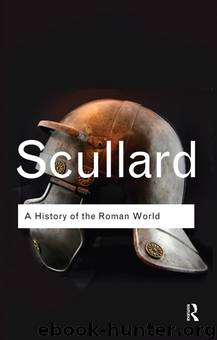A History of the Roman World by Scullard H. H

Author:Scullard, H. H. [H. H. Scullard]
Language: eng
Format: epub
ISBN: 9781136246357
Publisher: Taylor and Francis
2. THE THIRD MACEDONIAN WAR
The consul P. Licinius Crassus landed on the Illyrian coast near Apollonia, where he had some 37,000 men, many of whom were recruits. The officers and men were less experienced than in earlier days; the generation which had fought with Hannibal was passing, while the wars with Philip and Antiochus had not afforded such a hard apprenticeship. Perseus mustered an army of 43,000 men, half of whom were the kernel of Macedon’s power and formed the phalanx. This loyal force, which was larger than that with which Alexander the Great had crossed to Asia, was well-armed and well-disciplined by years of frontier warfare, though its officers lacked ability. But, like his father, Perseus was fighting for a lost cause and was the architect of his own downfall. Without the support of Greece, without naval power, he could not expect ultimate success; Rome’s resources could stand defeat after defeat. Like Philip, he could only hope that the Romans, if wearied by initial failures, might drop the war as they had the invasion of Africa after the defeat of Regulus. Strategically, the Second Macedonian War had shown the difficulty of a Roman attack from the Adriatic coast up through the mountain valleys to Macedon. Perseus chose rather to defend his kingdom in the south, though he may have strengthened the forts in the western valleys. From Macedon to Thessaly ran the strong Olympus range which continued after the pass of Tempe as Ossa and Pelion. Here was a strong defensive position where he could control the passes to Macedon and from which he could take the offensive in the plains of Thessaly, when opportunity offered, and fight in the enemy’s country.
Acting on this bold scheme, Perseus advanced past Tempe along the west of Ossa and took up a position near Larissa (spring 171). Here he was met by the Romans, who had advanced from the west past Gomphi. Near a hill named Callinicus the Romans were trounced in a severe cavalry engagement, but they refused Perseus’ offer to treat, rejecting anything short of unconditional surrender. They retired northwards on the west of the Peneus, while Perseus marched up the east bank. A second engagement, which the Roman annalists magnified into a great victory, was fought near Phalanna, and Perseus withdrew from Thessaly for the winter, though he left garrisons at critical points. Thereupon Licinius marched off to Boeotia. His failure can be partly explained by the smallness of his force; also he had not been adequately supported by the Roman fleet. The Roman admiral, instead of operating on the Thessalian coast, had spent his time plundering Boeotia by land: possibly Rome wished to win the war by land and thus avoid any obligation to her naval allies, Pergamum and Rhodes.
The campaign of 170 was uneventful. Hostilius Mancinus, who failed to force the passes of the Olympus range and withdrew from Larissa to Pharsalus, tried to curb his marauding troops and to protect his allies, though the commander of the fleet captured Abdera with great cruelty.
Download
This site does not store any files on its server. We only index and link to content provided by other sites. Please contact the content providers to delete copyright contents if any and email us, we'll remove relevant links or contents immediately.
The Daily Stoic by Holiday Ryan & Hanselman Stephen(3264)
The Fate of Rome: Climate, Disease, and the End of an Empire (The Princeton History of the Ancient World) by Kyle Harper(3030)
People of the Earth: An Introduction to World Prehistory by Dr. Brian Fagan & Nadia Durrani(2711)
Ancient Worlds by Michael Scott(2649)
Babylon's Ark by Lawrence Anthony(2648)
The Daily Stoic by Ryan Holiday & Stephen Hanselman(2524)
Foreign Devils on the Silk Road: The Search for the Lost Treasures of Central Asia by Peter Hopkirk(2442)
India's Ancient Past by R.S. Sharma(2432)
MOSES THE EGYPTIAN by Jan Assmann(2395)
The Complete Dead Sea Scrolls in English (7th Edition) (Penguin Classics) by Geza Vermes(2258)
Lost Technologies of Ancient Egypt by Christopher Dunn(2208)
The Earth Chronicles Handbook by Zecharia Sitchin(2204)
24 Hours in Ancient Rome by Philip Matyszak(2065)
Alexander the Great by Philip Freeman(2044)
Aztec by Gary Jennings(1992)
The Nine Waves of Creation by Carl Johan Calleman(1898)
Curse Tablets and Binding Spells from the Ancient World by Gager John G.;(1851)
Before Atlantis by Frank Joseph(1832)
Earthmare: The Lost Book of Wars by Cergat(1806)
